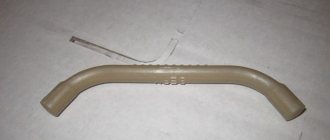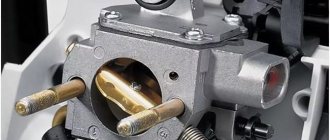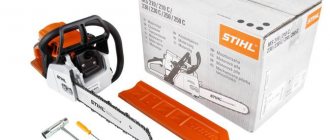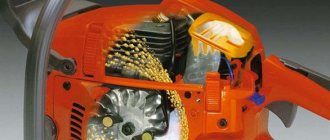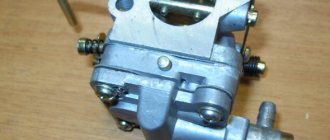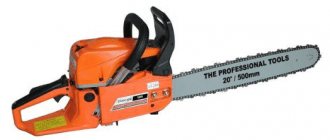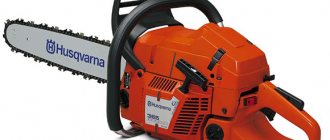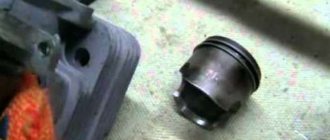The operating principle of a Walbro carburetor is based on a physical process such as air rarefaction. Essentially, a diaphragm carburetor acts as a fuel pump to pump fuel into it. Since the gas tank in the Husqvarna 365 chainsaw is located below the level of the carburetor, fuel cannot flow into it by gravity (as in chainsaws with float-type carburetors).
When the piston moves downward, a vacuum of air occurs in the crank chamber. From the crank chamber to the pulse chamber of the carburetor, through a special pressure fitting, there is an alternating supply of air, which lifts the membrane. When a pressure vacuum is created by the membrane, the valve alternately opens and closes, due to which fuel enters the carburetor. After passing the inlet valve, the fuel passes through the filter element and reaches the needle in a purified form.
In order for fuel to enter the main chamber, you need to lower the needle, to move which another membrane (control) is used. When the membrane moves up, it acts on the rod, and through the rocker arm the needle moves down (fuel enters the chamber). The movement of the control membrane is facilitated by the vacuum in the chamber that occurs when the piston moves up and down. That is why, when starting the engine cold, it should be pumped several times with the starter.
From the main chamber, fuel enters the working area. Here, using a diffuser, fuel is mixed with air. Then the finished mixture enters the combustion chamber of the engine.
Purpose of the chainsaw
The Husqvarna 340 chainsaw is a versatile, multi-purpose tool. It is used for cutting down trees, trimming branches, sawing firewood in private households. It is used to saw down wooden structures during construction. Copes with gas silicate blocks and a number of plastics.
The use of additional attachments turns the saw into a plane, ice auger, and even a water pump. It is not difficult to make a grinder out of a saw - a “grinder”.
To come in
Already registered? Sign in here.
- Login with Microsoft
- Login with Facebook
- Login with Twitter
- Login via LinkedIn
- Login via VKontakte
Related publications
For the first time I took apart a Huska electric saw! Cool, but I didn’t like the chain brake activation pull)
The screwdriver does not turn on from one of the batteries, and not always, sometimes it works normally, when you press the switch the LED lights up, then goes out, as if the current limiter is triggered, on the other battery it works more or less, but with a slight overload too turns off, but when switching reverse it works again, help, who knows what's wrong.
Specifications
The main and additional technical characteristics of the Husqvarna 340 chainsaw are divided into groups and shown in the photo below:
The X-TORQ® chainsaw engine is not only powerful and economical, but also environmentally friendly. It has significantly reduced emissions of harmful gases. This became possible due to changes in the combustion process of the fuel mixture.
The engine starting system of the Husqvarna saw is modernized in comparison with other models and allows it to be easily started at any temperature.
The air filter does not require frequent cleaning due to the additional use of centrifugal air purification. Improved filtration extends the life of parts throughout the engine.
The automatic adjustment system of the Husqvarna 340 carburetor during operation ensures that the engine can deliver full power regardless of the type of fuel mixture, degree of contamination of the air filter, ambient temperature and humidity.
Profitability is manifested not only in fuel savings, but also in oil savings. It is not supplied, unlike other types of saws, to lubricate the chain while it is standing still.
Anti-vibration system. All saw handles are isolated from the engine by springs.
Safety is achieved by the presence of a brake and a chain limiter. The chain brake operates in manual and automatic (inertial) modes. The chain will not cause harm to the operator if it breaks.
All characteristics of the saw are presented in more detail in the “Operating Instructions”.
Model Husqvarna 372XP - equipment and applications
This saw is in demand due to its ability to work intensively under high loads with virtually no breaks. The model is characterized by high wear resistance of parts, a reliable motor and a durable body.
The main characteristics of the model include:
- Cylinder volume – 70.6 cm3;
- Motor power – 3.9 kW or 5.3 l. With.;
- The volume of the fuel tank is 775 ml;
- Oil tank capacity – 450 ml;
- Possibility to use original attachments for Husqvarna chainsaws;
- The operating weight of the saw is 7 kg.
This tool has proven itself well in the logging industry and construction. The model is supplied with a long bar, chain, case, instructions and warranty card.
Answers to frequently asked questions
The Husqvarna 340 chainsaw requires careful handling. Violation of operating rules leads to changes in adjustments and even breakdowns, but some malfunctions can be eliminated with your own hands. Let's take a closer look at how this is done.
What tires can be installed on a Husqvarna to replace a faulty one? First of all, the technical parameters must match. The tire length is 13-18 inches (33-45 cm), the groove width is 1.3 mm and the maximum number of driven sprocket teeth is 10.
Why does the Husqvarna 340 chainsaw chain lubricant flow in a stream? The answer here, as a rule, is one - the seal of the oil pump or the interface between the oil supply hose is worn out to the limit. You can learn more about this by watching the video.
Many inexperienced users are interested in how to adjust the oil supply for chain lubrication. There is an adjusting screw at the bottom of the chainsaw. Turning it increases or decreases the oil supply to the chain. How this is done is shown in the video
How to remove the sprocket on Husqvarna 340? The process of removing the drive sprocket is not a simple one. To perform this work, it is necessary to remove the clutch along with the drum. How to do this is clearly shown in the video.
Having experience in performing plumbing work and tools, knowing the structure of a chainsaw, it will not be difficult to replace the sprocket on the Husqvarna 340 yourself.
How to repair a drive brake
So, how to repair the drive mechanism brake . It serves for emergency braking of the saw chain to avoid injury to the operator, in our person - the lumberjack. This is one of the safety systems that is designed on the tool. On “horned” analogues of chainsaws, this system is absent as unnecessary, and that’s understandable. In addition to the safety of the operator himself, the chain braking system serves to preserve the mechanism itself when jammed. Brake failure is rare; the causes of the failure are infrequent maintenance of the saw, lack of cleaning, wear due to a long service life, and improper use of the tool during sawing.
When does this braking system engage? Most often, the brake is automatically activated during kickback, when the sawyer touches an object (wood) with the tip of the tire, and a sudden obstacle or impact appears. In another case, the chain brake is activated when the bar is clamped in the cut, and the lumberjack tries to free the chainsaw with sudden movements. From an inertial impact, protection is triggered - stopping the chain. Also, the (operator) lumberjack can turn on the brake of the chainsaw himself - manually, using the upper lever (screen), also known as the recoil handle. This is necessary, as a rule, in case of “whims” of the tool, when the chain continues to rotate without gas supply, or in case of clutch or carburetor malfunctions.
Working principle of the brake
Let's consider the principle of brake operation. The design of the mechanism is simple and unpretentious. This is a purely mechanical process. The starting switch for the brake system is the lever (screen) we have already mentioned, which is a durable element on the upper front surface of the chainsaw above the muffler. The screen is located just behind the operator’s hand, almost close, it is connected to the lid. But, since we rotate the tool while working, the screen may not be behind the hand.
General picture of the braking system
Sliding lever without spring in cocked state
Sliding lever without spring when the trigger is released
Sliding lever without a spring with the trigger releasedThe screen is fixed by a return spring at the base of the mount and a trigger switch. When the tire hits or rebounds, the screen touches and rests on the sawyer’s hand and further along the chain he turns on the trigger, which is interconnected with the screen. In the normal position, the trigger compresses the spring (not to be confused with the return spring), and when triggered, it opens it and secures it with a locking latch (latch). The sliding lever, which is located inside the spring, in turn tightens the metal strip. A metal band is placed around the clutch basket (clutch drum) and it tightens (clamps) the drum, which stops rotating. The chainsaw chain stops.
DIY chainsaw carburetor repair instructions
A chainsaw is needed in construction, gardening, and landscaping - its presence greatly simplifies the performance of a number of wood processing tasks. The main component of this tool is the engine, the operation of which largely depends on the condition and settings of the carburetor. This is where the fuel mixture is prepared. This means that if the saw does not start, stalls, or does not provide the required power, it is likely that the reason for this is improper operation of the carburetor. Fortunately, in many cases you can deal with this on your own. Only for this you need to know and understand the structure and operating principle of this unit and, of course, the chainsaw itself.
Features of working with a chainsaw Partner p340s
There is a list of safety rules that must be followed when working with the Partner 340 chainsaw. First of all, this applies to work clothing, it must be thick to protect it from the saw in the event of a breakdown.
Also, safety precautions for working with the Partner 340 chainsaw concern the sawing process. The following requirements must be adhered to:
- Before carrying out work, it is necessary to calculate the direction of fall. This takes into account the direction of the wind, the slope of the soil and the tree itself.
- The area around the tree must be cleared of bushes, foreign objects, and undergrowth. The space located at a 45 degree angle behind and on the sides of the tree is removed.
- The safe distance from a falling tree is two tree lengths. There should be no strangers in this area.
What fuel is used in Partner 340 chainsaws?
The fuel mixture for Partner 340 saws is a mixture of AI-95 or AI-92 gasoline in combination with oil for two-stroke engines. The proportion is 1000:20 grams. This ratio must be applied after engine break-in. To do this, the fuel mixture is formed by mixing one liter of gasoline with 35 grams of oil. The running-in volume is 1.5-2 tanks.
How does a chainsaw carburetor work?
The main purpose of a carburetor is to mix fuel with air in the required proportions. If the latter are violated, this almost instantly affects the operation of the engine.
Chainsaw carburetor Stihl MS 181 C BE
Chainsaw carburetors may differ in design. However, their basic elements and operating principle remain approximately the same.
Carburetor design:
- The basis
This is a wind tunnel, across which there is an air damper - with its help the intensity of the air supply is regulated.
This part is where the base tube narrows - here the air flow speed increases, i.e. air is always supplied to the carburetor under some pressure.
In this area, the fuel comes into contact with the air flow. Fuel enters the atomizer from the float chamber through a nozzle (dispenser).
- Float chamber
This is a container that allows you to keep the fuel mixture in a stable state.
Chainsaw carburetor design diagram
A chainsaw carburetor works according to the following principle:
- when the engine starts, the main damper opens and a stream of air is supplied into the air channel at a certain speed;
- the speed of the air flow, as well as the level of the float in the chamber, are regulated by the position of the damper, namely due to the difference in pressure in the float chamber and the air channel;
- fuel from the float chamber is sucked into the nozzle, and from there into the diffuser;
- passing through the diffuser, the air captures the fuel entering there;
- the resulting mixture is fed into the cylinder cavities through the intake channels.
The design and principle of operation of the Husqvarna carburetor
To successfully configure the Husqvarna chainsaw carburetor, you need to know its structure and understand how it works. In fact, everything is not as complicated as it seems at first glance.
The saw carburetor has a built-in fuel pump, which is responsible for transporting the mixture of gasoline and oil, as well as a diaphragm, a needle valve with a rocker arm. Their joint work makes it possible to dose the fuel supply to the main chamber and two dampers.
One of the dampers is designed to regulate the flow of fuel into the cylinder when you press the gas, it is called the throttle, the second is responsible for limiting the flow of air from the air filter to facilitate starting a cold Husqvarna chainsaw.
At the moment when the operator shuts off the air supply to the carburetor using the air damper, the fuel mixture becomes leaner and its supply to the cylinder increases, due to which the chainsaw starts much easier than when a cold start is carried out in normal mode.
For example, if the chainsaw is stored improperly, the valve may stick, the fuel supply will stop, which will make the engine impossible to operate. Also, malfunctions in the operation of the nozzle can cause air to leak into the main fuel chamber of the carburetor. In such cases, adjusting the position of the adjusting screws will not correct the situation; repair or replacement of the unit will be required.
Three adjusting screws installed in the carburetor body are responsible for adjusting the quality and quantity of the mixture, as well as the number of crankshaft revolutions in idle mode:
- screw (L) – regulates the amount of fuel in low and medium speed modes;
- (H) – responsible for traction at high speeds and their number;
- (T) - changes the position of the throttle valve, thereby regulating the amount of fuel mixture entering the cylinder and the operation of the tool engine in idle mode.
Why is primary adjustment needed?
During the first hours of operation, the 2-stroke chainsaw engine requires running-in, on which the quality of its further operation depends. During the running-in process, the carburetor is initially adjusted - the optimal parameters for preparing and supplying the fuel mixture are established.
Initial running-in of the chainsaw: working with thin material
Most modern chainsaws are sold adjusted. However, it doesn’t hurt to check the quality of the factory settings - in the end, it’s you who will have to work with the tool.
When starting up for the first time, the chainsaw should operate in a gentle mode. Therefore, for several hours after start, it is recommended not to overload the engine and cut only small branches and trunks up to 10 cm thick.
Simple rules will help you insure against malfunctions of the chainsaw carburetor:
- Always mix gasoline and oil according to the manufacturer's instructions.
Proportions of the fuel mixture for a chainsaw engine
The chainsaw must start correctly, ensure a stable rotation speed of the sprocket and a smooth increase/decrease in power. There should be no extraneous knocks, pops or noises when the engine is running.
Professional hand chainsaw at work
The main thing during the initial running-in of the tool is to ensure that the fuel consumption corresponds to the power used, i.e. in practice, the saw should not go out, “sneeze”, smoke or run jerkily.
Video for a snack
Good luck and see you again! Andrey Noak was with you.
Why do you need to adjust the Husqvarna carburetor?
The carburetor is one of the fundamental mechanical components that make up a chainsaw. His tasks include mixing fuel with air and supplying the acquired composition to the engine. Husqvarna 137 carburetor adjustment, DIY chainsaw repair too. But during the operation of the chainsaw, situations arise when adjusting the Husqvarna carburetor becomes necessary. Depending on the circumstances, the carburetor of chainsaw model 142 and other series is adjusted to prevent the following situations:
- the presence of interruptions in the operation of the motor, accompanied by its shutdown;
- unnecessary consumption of fuel during work.
Since the carburetor affects the quality of the fuel, in the first case the need for carburetor options saw 137 or other professional series, such as Husqvarna 240 or 260, implies an impact specifically on a sufficient amount of combustible raw material entering the carburetor for mixing with the air mass. It is clear that the greatest productivity is possible only with a certain ratio of these substances. The second point in adjusting the carburetor mixer of a chainsaw is caused by a lack of incoming air, which provokes the injected gasoline to fail to burn and be released in the form of thick smoke. A timely change of characteristics with your own hands to reduce the amount of injected fuel will allow you to significantly more quickly reduce the consumption of this product.
Read:
Do-it-yourself repairs will save not only the budget, but also the time spent on transportation and queues in the workshop. Adjusting the carburetor of the Husqvarna 142 chainsaw.... This also applies to replacing various spare parts in gas-powered tools, such as a chain for a chainsaw or a universal trimmer head for a brush cutter, or oils for electric drive products.
How to recognize carburetor failures?
Typical carburetor malfunctions are easy to recognize. They are expressed in the fact that the chainsaw engine starts and immediately stalls or shows no signs of life at all. Well, or it consumes fuel with all its might, producing clouds of black smoke and aggressive vibrations instead of the required power.
Operation diagram of a chainsaw carburetor
Carburetor settings may be affected by:
- lack of fixation of the adjusting screws;
Chainsaw adjustment screws
New CPG chainsaw Husqvarna 365
Chainsaw air filter with nylon insert
Any problems found should be corrected immediately. But how can you determine that the problem is in the carburetor? To do this, watch how your tool works.
Typical signs that the carburetor settings are off include:
- Unstable motor operation
As a rule, the reason for this is the use of the wrong (lean) fuel mixture.
- Excessive fuel consumption
It is expressed in an increased release of exhaust exhaust, which turns black. This means that fuel is not completely consumed, i.e. the mixture is oversaturated.
The carburetor is adjusted correctly - the saw starts the first time
- Arbitrary changes in engine power
May be associated with damage to the fastening of the adjusting screws or the protective cap.
- Increased fuel consumption accompanied by vibrations and pops
This indicates critical wear of the piston group, so adjusting the carburetor will only postpone major repairs for some time.
- Sneezing and engine jerking
This picture is observed when the carburetor channels are clogged or its filters are faulty. In this case, adjustment should be carried out only after thoroughly washing the unit.
Chainsaw fuel filter
Despite the fact that the carburetor is the most complex part of the engine, you should not be upset if you detect malfunctions in its operation. Instead, you need to arm yourself with some tools, a design diagram of the unit and sound logic.
Husqvarna 142 in operation
We prepared the fuel mixture on the basis of AI 92 gasoline and Husqvarna HP branded two-stroke oil in a ratio of 50 to 1. It is interesting to note here that if oil added in the specified ratio is not available, the manufacturer allows the short-term use of high-quality oil diluted with gasoline in the ratio 33 to 1.
We operated the Husqvarna 142 for about an hour. It is ideal as a household chainsaw: almost complete absence of vibrations in the hands, a completely bearable noise level and, most importantly, excellent cutting abilities. Fresh pine and dry birch trunks with a diameter of 26 cm were repeatedly sawed in an average of 7 s each. The dry oak yielded a little more slowly; It took approximately 14 seconds to cut a log with a diameter of 24 cm. The cutting speeds are slightly lower than those of the professional chainsaws that we tested, but these are saws of a different order of cost. Husqvarna 142 is not afraid of working at full power; high speeds are even recommended in the instructions. The brake works perfectly - the chain stops instantly.
Read also: Grippers for metal sheets
Then an analysis was made of reviews from Husqvarna 142 owners on three specialized forums
We took into account only those publications whose authors have been registered for a long time and do not use a chainsaw professionally, i.e. not every day for several years. The results of the analysis were not surprising and are briefly as follows: the piston group is reliable, the tire is strong, the saw is comfortable and unpretentious to fuel
Failures occur infrequently, but are caused by the deadline for replacing consumables or errors in preparing the fuel mixture
The results of the analysis were not surprising and are briefly as follows: the piston group is reliable, the tire is strong, the saw is comfortable and unpretentious to fuel. Failures do occur infrequently, but are caused by the deadline for replacing consumables or errors in preparing the fuel mixture.
Do-it-yourself disassembly: nothing complicated
First of all, you need to prepare a place for disassembly. This could be a workbench or a regular table. In addition, you need a rectangular piece of fabric or cardboard - on it you will carefully fold the carburetor parts. And finally, a tool: for disassembly you will need a set of open-end wrenches and screwdrivers, a special cleaning compound and an ultrasonic cavitation bath.
Chainsaw carburetor repair tool
First, you will have to dismantle the chainsaw carburetor. This is done in this order:
- To get to the carburetor, you need to remove the top cover of the chainsaw, secured with three bolts.
Removing the carburetor cover
Removing the fuel hose and drive rod
Removing the throttle cable
After removing the gasoline hose, the carburetor is ready for disassembly
The carburetor must be disassembled in the order prescribed by the design and functional solutions of its elements. The parts of the chainsaw carburetor do not differ in size, so you need to fold them carefully and in order, trying not to lose anything.
Disassembling a chainsaw carburetor in the photo
After disassembly, it is necessary to carry out troubleshooting and replace damaged or worn parts. Next, the entire set should be washed with a special product, dried and wiped with a dry lint-free cloth. The jets and tubes of the assembly must be purged with compressed air, or, in order to more thoroughly remove formations on their internal surfaces, they must be treated with ultrasound beforehand.
Customization technology
The main tool used to tighten screws is a screwdriver that fits their slots. On different carburetors they are flat, cruciform, with an internal or external hexagon, or an asterisk.
Expert opinion
Torsunov Pavel Maksimovich
Some tool manufacturers Husqvarna, Homelite, MTD equip their carburetors with jets for a special screwdriver. This was done to make it as difficult as possible for the owner to independently adjust the carburetor.
It can be assumed that the purpose of this is to “make money” on the sale of screwdrivers for adjustment: they are really expensive. But in fact, this is done to protect the saw engine from incorrectly set maximum speeds.
Control the setting with a tachometer. If it is not there, you will have to rely on your own hearing, and this is not always effective.
Step-by-step instruction
The main steps for setting up a carburetor:
- adjustment at low speeds;
- setting the correct fuel supply at maximum speed;
- fine tuning at idle speed;
- checking the operation of the tool in all modes.
3 screws are used for adjustment:
- T – is responsible for fine tuning at idle;
- H – setting of operation at maximum speed;
- L – adjustment of the formation of the fuel mixture at low speeds.
Setup process
The adjustment consists of the following steps:
- Set screws L and H to standard setting. This is 1/5 turn of the screws until they are fully tightened.
- Start the engine and warm it up a little.
- Adjust the low speed mode with screws L and idle speed T. First, tighten screw L until maximum engine speed is obtained. Then release it 1/4, and use screw T to return the idle speed to normal.
- After adjusting the operation at the “bottoms”, adjust the traction and maximum speed. To do this, slowly tighten screw H and check the speed using the electronic tachometer. Do not exceed the maximum speed limits recommended class=”aligncenter” width=”749″ height=”206″[/img]
- Adjustment of screw L is stopped when the engine runs smoothly, moves smoothly from low to high speeds and does not smoke.
- The final stage is to check the operation of the saw in all modes. First let the tool cool, then do a test run at idle speed.
- If the tool operates normally, test it under load.
- If there is insufficient power, repeat the adjustment of screw H by unscrewing it and checking the traction again. Loss of traction at maximum speed is an indicator of CPG wear or poor fuel quality.
Some nuances
During the process of setting up the carburetor, some non-standard and dangerous situations for the performance of the tool may arise:
- Tightening the screw L too much relative to H can lead to the formation of a lean fuel-air mixture. When there is a lot of air and little gasoline in the carburetor, the piston group dries out and may fail.
- Factory Chinese carburetors are configured on benches taking into account the characteristics of each chainsaw. Any change in the position of the screws during adjustment must be remembered or recorded. This will help you return to factory settings if the engine does not start.
- New carburetors for Chinese saws are regulated at the factories by a standard number of revolutions or arbitrarily. They may require adjustment immediately after installation on a particular instrument.
Reference! Currently, there are many models of chainsaws made in China, less often in Europe, on the market, which simply do not have adjusting screws. Their adjustment only involves adjusting the idle speed with one screw, when the tool stalls or produces rare revolutions).
How to understand that the setting is correct
The following signs indicate effective and correct configuration:
- The chain does not move at idle;
- The motor runs smoothly;
- There are no interruptions in operation when starting and pressing the gas.
Carburetor tuning: main points
Reassembly of the carburetor is carried out only after complete cleaning, drying and blowing with compressed air. However, do not forget that some gaskets and seals, even if there is no damage, must be replaced.
You can begin adjusting the carburetor if it is correctly troubleshooted, of high quality assembly and flawless re-installation on the engine.
Principles of carburetor tuning:
- screws H and L adjust the ratio of air and fuel mixture, i.e. throttle position. Tightening the screws clockwise leads to a lean mixture and the engine switches to low speeds. When unscrewing (counterclockwise), the mixture becomes richer and the engine speed increases;
- screw T is responsible for adjusting the idle speed: turning it clockwise increases their number, counterclockwise - decreases it;
- The screws are adjusted in LHT order.
Chainsaw carburetor calibration
The general adjustment algorithm looks something like this:
- Initially, the highest idle speed is found by turning screw L and then returning ¼ turn counterclockwise. If the chain rotates at idle, turn screw T in the same direction until it stops completely.
- With the engine warm and running at full speed, turn screw H ¼ turn to the left, then let the engine run for 10 seconds and check the maximum speed using a tachometer. It must correspond to the number indicated in the instrument passport.
- After calibration with screws L and H, using screw T, the idle speed is adjusted. If everything is done correctly, the engine will operate evenly in all its positions.
Reminders for calibrating the carburetor on the chainsaw body
Upon completion of the adjustment, all that remains is to reinstall the chainsaw cover with the insulating gasket, after which you can begin the main work. If the settings are correct, the chainsaw engine will receive the optimal fuel mixture. This will ensure its normal efficiency, as well as overall comfort and safety of working with the tool.
Lightweight brushcutter Husqvarna 323R. Description, characteristics, videos and owner reviews
The 323R outperforms most budget Husqvarna lawn mowers in terms of engine power. It is increased to 1.2 hp.
Husqvarna 323R is used to maintain clean park areas, private lawns and golf courses.
Both a trimmer head and special knives can be used as a cutting tool.
The trimmer gearbox is able to withstand heavy loads and carry out work for a long period of time.
Basic equipment
The lawn mower is supplied to new customers with the following kit: a trimmer, blades, a bar, a mounting belt, an instruction manual and a small set of maintenance tools.
Specifications
| Cylinder displacement, cubic meters cm | 24.5 cm3 |
| Rated power at operating speed Energy | 0.9 kW |
| Maximum power take-off speed | 8300 rpm |
| Fuel tank volume | 0.5 l |
| Sound pressure at the operator's ear | 95 dB(A) |
| Weight | 5.1kg |
Device
- The length of the handle of the Husqvarna 323R lawn mower is adjustable for maximum comfort during work.
- The belt is made of composite materials and evenly distributes the load along the spine.
- Easy start of the car is ensured thanks to the fuel pumping system.
Smart Start® Combination Guard
Features of application
Before you start working on the Husqvarna 323R lawn mower, you must inspect it for wear or abnormal position of parts, and also check for the presence of the fuel mixture.
When mowing the grass, you need to be careful because the blades rotate at high speed and there is a possibility of stones and other hard objects flying out.
When operating the mower, it is recommended to wear a protective suit and goggles.
Brief review of the Chinese chainsaw Husqvarna 5200
The non-original Husqvarna 5200 chainsaw is intended for home use: sawing wood, gardening, preparing firewood. The product weighs 5.3 kg. The power of the two-stroke power plant is 3.4 liters. With. The chainsaw is started using a manual starter. Contactless ignition system. Built-in vibration protection. The chain tensioner is located on the side of the unit, and the lubrication supply to the chain is automatic. Tires 52 cm long and chains of 72 links are used, which allows you to saw fairly large logs. The chain brake will instantly stop a running chainsaw. Hand protection and case not included.
Husqvarna 5200 - China
Peculiarities
- low price;
- automatic lubrication supply;
- vibration protection;
- chain brake;
- power 3.4 l. With.;
- long tire;
- side chain tensioner.
This is interesting: Chainsaws Husqvarna 55: characteristics, features
Popular malfunctions of the Husqvarna 254 XP chainsaw
Even despite the high build quality of professional Husqvarna chainsaws, there are a number of typical malfunctions, most often occurring after 3-4 years of active use. The most common:
- Problems with water getting into the carburetor channels, or carburetor breakdowns caused by fuel quality. In the first case, the fuel supply system is practically impossible to adjust, and in the second, deposits form inside the system, which render the carburetor unusable.
- When applying excessive load to the saw while operating on a mixture depleted of oil, engine malfunctions occur - scuffing and jamming of the pistons.
- During active operation in dusty conditions, bearing malfunctions occur.
Other models
Manufacturers produce different models of Husqvarna chainsaws; the Husqvarna 576 xp 18 is in great demand. This is a professional tool that belongs to the premium class. It is designed for use in logging operations.
The saw is equipped with an engine that has a minimal level of harmful emissions. The unit is economical, the body is elongated. The center of gravity is high, which ensures comfortable work.
The 560 xp model is in great demand among consumers. This is a professional saw with a gasoline engine, it is designed for woodcutters. The unit is designed to operate during long working hours.
The device is multifunctional. With its help you can cut down forest and saw large logs. The carburetor is adjusted automatically. The equipment starts up quickly and operates at maximum power even under difficult operating conditions.
Modifications
Husqvarna 240 has two modifications, these are Husqvarna 240 e series and Husqvarna 240 e series TrioBrake.
Kickback protection
In the e series configuration, the saw is additionally equipped with a Smart Start system, which is designed to make it easier to start the chainsaw, as well as hinged fuel and oil tank covers, and a chain tensioning system without the help of an additional key. Essentially, the Husqvarna 240 e-series is a luxury version of the basic chainsaw model.
Husqvarna keyless chain tensioning system
Husqvarna e-series TrioBrake is also a luxury model of the 240, only additionally equipped with innovative TrioBrake technology, which protects the operator in the event of a kickback.
The video below provides a description of how the system works and why it is needed.
Malfunction of the chain lubrication system in the chainsaw
What types of breakdowns occur in the chain lubrication system:
- No or low oil supply
- Oil leakage
In the first case, we first inspect the channels through which oil is supplied to the tire and clean them. Their clogging is a fairly common occurrence.
If there is significant oil leakage (small oil leakage is normal for all gasoline saws), you should check the tightness of the tubes and fittings of the oil pump. Tubes may fall off and even crack. Violation of the tightness of the tubes is eliminated by replacing them or sealing them with sealing material.
As for oil pumps, they may have different designs for different models of chainsaws, and the drive is also carried out differently (as a rule, the drive is carried out by a drive sprocket or a special gear on the crankshaft). If there is a problem with the oil pump, then most often you will not have to completely replace this entire unit; it will be enough to replace its moving part (plunger), which most often fails due to the ingress of large amounts of dirt and sawdust.
The most serious damage is a crack in the oil pump housing. In this case, you will have to completely replace it.
